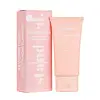What's inside
What's inside
 Key Ingredients
Key Ingredients

 Benefits
Benefits

 Concerns
Concerns

 Ingredients Side-by-side
Ingredients Side-by-side

Water
Skin ConditioningPropanediol
SolventCaprylic/Capric Triglyceride
MaskingSqualane
EmollientGlycerin
HumectantSodium Acrylates Copolymer
Butyrospermum Parkii Oil
EmollientHelianthus Annuus Seed Oil
EmollientPunica Granatum Sterols
Skin ConditioningLactobacillus Ferment
Skin ConditioningInulin
Skin ConditioningCeramide NP
Skin ConditioningSodium Hyaluronate
HumectantAlpha-Glucan Oligosaccharide
CleansingLecithin
EmollientBisabolol
MaskingTocopheryl Acetate
AntioxidantHydroxydecyl Ubiquinone
AntioxidantAcrylates/C10-30 Alkyl Acrylate Crosspolymer
Emulsion StabilisingAmmonium Acryloyldimethyltaurate/Vp Copolymer
Maltodextrin
AbsorbentSilica
AbrasiveSodium Phytate
Ethylhexylglycerin
Skin ConditioningPhenoxyethanol
PreservativeMica
Cosmetic ColorantCI 77891
Cosmetic ColorantWater, Propanediol, Caprylic/Capric Triglyceride, Squalane, Glycerin, Sodium Acrylates Copolymer, Butyrospermum Parkii Oil, Helianthus Annuus Seed Oil, Punica Granatum Sterols, Lactobacillus Ferment, Inulin, Ceramide NP, Sodium Hyaluronate, Alpha-Glucan Oligosaccharide, Lecithin, Bisabolol, Tocopheryl Acetate, Hydroxydecyl Ubiquinone, Acrylates/C10-30 Alkyl Acrylate Crosspolymer, Ammonium Acryloyldimethyltaurate/Vp Copolymer, Maltodextrin, Silica, Sodium Phytate, Ethylhexylglycerin, Phenoxyethanol, Mica, CI 77891
Water
Skin ConditioningAloe Barbadensis Leaf Juice
Skin ConditioningRosa Damascena Flower
Skin ConditioningSqualane
EmollientCetearyl Olivate
Sorbitan Olivate
EmulsifyingPropanediol
SolventPropylene Glycol
HumectantCetyl Alcohol
EmollientHydrolyzed Wheat Protein
Skin ConditioningAllantoin
Skin ConditioningPolyacrylate Crosspolymer-6
Emulsion StabilisingAnthemis Nobilis Flower Extract
MaskingGluconolactone
Skin ConditioningCucumis Sativus Fruit Extract
EmollientCalcium Gluconate
HumectantSodium Phytate
Citric Acid
BufferingPhenoxyethanol
PreservativeSodium Benzoate
MaskingEthylhexylglycerin
Skin ConditioningPotassium Sorbate
PreservativeWater, Aloe Barbadensis Leaf Juice, Rosa Damascena Flower, Squalane, Cetearyl Olivate, Sorbitan Olivate, Propanediol, Propylene Glycol, Cetyl Alcohol, Hydrolyzed Wheat Protein, Allantoin, Polyacrylate Crosspolymer-6, Anthemis Nobilis Flower Extract, Gluconolactone, Cucumis Sativus Fruit Extract, Calcium Gluconate, Sodium Phytate, Citric Acid, Phenoxyethanol, Sodium Benzoate, Ethylhexylglycerin, Potassium Sorbate
Ingredients Explained
These ingredients are found in both products.
Ingredients higher up in an ingredient list are typically present in a larger amount.
Ethylhexylglycerin (we can't pronounce this either) is commonly used as a preservative and skin softener. It is derived from glyceryl.
You might see Ethylhexylglycerin often paired with other preservatives such as phenoxyethanol. Ethylhexylglycerin has been found to increase the effectiveness of these other preservatives.
Phenoxyethanol is a preservative that has germicide, antimicrobial, and aromatic properties. Studies show that phenoxyethanol can prevent microbial growth. By itself, it has a scent that is similar to that of a rose.
It's often used in formulations along with Caprylyl Glycol to preserve the shelf life of products.
Propanediol is an all-star ingredient. It softens, hydrates, and smooths the skin.
It’s often used to:
Propanediol is not likely to cause sensitivity and considered safe to use. It is derived from corn or petroleum with a clear color and no scent.
Learn more about PropanediolSodium Phytate is the synthetic salt form of phytic acid. Phytic acid is an antioxidant and can be found in plant seeds.
Sodium Phytate is a chelating agent. Chelating agents help prevent metals from binding to water. This helps stabilize the ingredients and the product.
Squalane is an emollient that helps the skin hold onto moisture. It's an oily liquid that occurs naturally in certain types of fish and plant oils.
Because squalane boosts hydration in the skin, it also comes with plenty of benefits: it is an antioxidant and can help fight free radicals and skin damage. Squalane is also found to have a detoxifying effect when applied.
Squalane comes from squalene, which occurs naturally within the sebum of our skin. It is one of the oils our skin produces to keep itself hydrated. Squalane is the hydrogenated version of squalene and has a longer shelf life.
Research shows that squalane is non-irritating (even at 100% concentration).
In general, it's a fantastic ingredient. It does a great job at hydrating the skin, and it's suitable for those with sensitive skin.
The source of squalane may impact malassezia / fungal acne. This is because olive oil derived squalane can contain impurities such as fatty acids and plant waxes. Sugarcane derived squalane is recommended for anyone with malassezia concerns.
Is squalane vegan?
This depends on the source. Squalane can be derived from both plants and animals. Most squalane used in skincare comes from plants.
Please note: the source of squalane is only known if disclosed by the brand. We recommend reaching out to the brand if you have any questions about their squalane.
Read more about squalene with an "e".
Is squalane an oil?
Squalane is often called an oil, but it’s technically not; it’s a hydrocarbon, meaning it’s only made of carbon and hydrogen, unlike true oils which are triglycerides made of fatty acids and glycerol.
The term “oil-free” isn’t regulated, so companies can define it however they want. Some exclude all oils, while others just avoid mineral oil or comedogenic oils.
While some people avoid oils thinking they cause breakouts, the right kind of oil (or oil-like ingredient like squalane) can actually help balance and hydrate your skin. It’s worth testing out simple oils or squalane to see what works best for your skin.
Learn more about SqualaneWater. It's the most common cosmetic ingredient of all. You'll usually see it at the top of ingredient lists, meaning that it makes up the largest part of the product.
So why is it so popular? Water most often acts as a solvent - this means that it helps dissolve other ingredients into the formulation.
You'll also recognize water as that liquid we all need to stay alive. If you see this, drink a glass of water. Stay hydrated!
Learn more about Water